Holidays and Festivals
What do these photos tell you about the holidays and festivals farmers and ranchers celebrated?
Melon Day In Rocky Ford (1893)
The women in this photo are eating watermelons at the Melon Day Festival at Rocky Ford, Colorado.
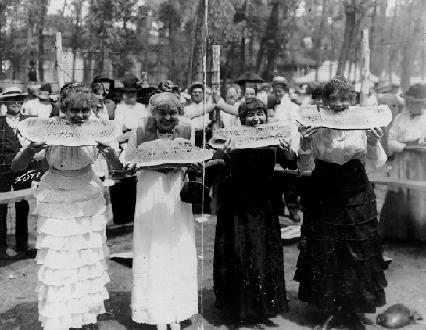
Photo: Colorado Historical Society
More About This Topic
In the late 1800s, many towns in Colorado held a festival each fall. The festival advertised the special crops grown by the local farmers and was a time to have fun. The oldest festival was Rocky Ford's Melon Day, held on the first Thursday of September. It was begun in 1878 by Senator George W. Swink, an Arkansas Valley pioneer. By the 1890s, thousands of visitors attended Melon Day each year. The farmers gave away all the watermelons and cantaloupes that people could eat.
Their Own Words
In the following excerpt, Sarah Savage Brillhart describes a "Watermelon Day" festival:
"In other parts of the state, a 'Watermelon Day' festival was held in the fall as the bountiful muskmelon (cantaloupe, to you) and watermelon crop ripened. Wagon loads of the sweet juicy fruits were pulled into the center of towns like Rocky Ford and the countryside was invited to feast."
Source: From Mary Ruth Kauffman, Sarah, Her 100 Years [the Life of Sarah Savage Brillhart], (Boulder: Gambrill Properties Publisher, 1982): 24.
Colorado Springs Sunflower Carnival
This photo shows a horse-drawn float at the Sunflower Carnival at Colorado Springs. The people are riding in a hay wagon decorated with crepe paper, flags and flowers. The man sanding in front is dressed like Uncle Sam.
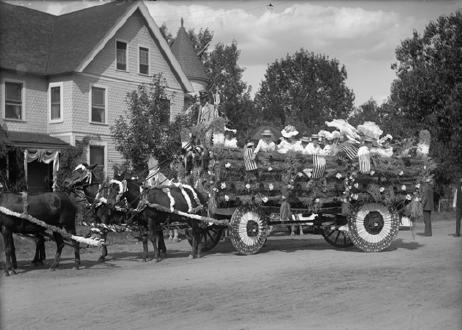
Photo: Denver Public Library, Western History Collection
More About This Topic
Colorado Springs had a Sunflower Carnival. Greeley had a Potato Day. Grand Junction had a Peach Day festival to celebrate the fruit for which it was best known. Former President William Howard Taft was the guest of honor at Peach Day in 1909.
Their Own Words
"At half past two o'clock the pavilion was thrown open to guests and visitors and for a while the crush and jam was so great that it was almost impossible to move back and forth. There was enough for all, however, and if the visitors did not get their fill of fruits and melons, it was their own fault. 'Wonderful! Wonderful!!' 'Did you ever see the like?' 'Did that fruit grow here?' And all such expressions could be heard on every side as the visitors looked upon the display of tempting and marvelously beautiful and perfect fruit shown by the fruit growers. It was a beautiful sight and no mistake."
Source: From the the Grand Junction News, Sept. 9, 1893.
Sterling Harvest Festival
This photo shows a parade on the main street of Sterling, Colorado during the town's Harvest Festival.
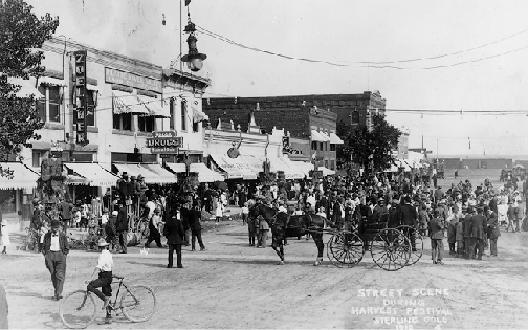
Photo: Denver Public Library, Western History Collection
More About This Topic
Sterling had a Harvest Festival, which it celebrated with a parade. Longmont had a Pumpkin Pie Day. Fort Collins had Lamb Day, which featured all the barbecued lamb one could eat. For many years, Boulder had a Strawberry Festival early in the summer.
Their Own Words
"In the early years in Colorado, strawberries grew profusely and were big and luscious. One of Boulder's activities each year was a big strawberry festival when all the strawberries and cream and cake you could eat were yours for the eating. . . . You never saw such baskets of berries! The first year we were here we got to go and eat all we could hold. This tradition was carried on for several years."
Source: From Mary Ruth Kauffman, Sarah, Her 100 Years [the Life of Sarah Savage Brillhart], (Boulder: Gambrill Properties Publisher, 1982): 24.
Colorado State Fair
This photo shows a horse-drawn fire wagon in a parade in Pueblo, Colorado. The parade was held to celebrate the opening of the Colorado State Fair.
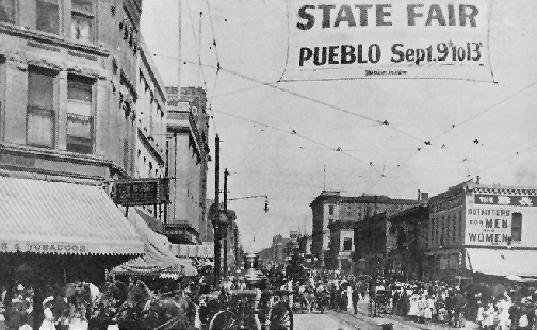
Photo: N/A
More About This Topic
In October 1887, the city of Pueblo held the first State Fair in Colorado. People came from many parts of the state to show off the fine vegetables, fruit, grain, and animals they had raised. It quickly became the largest agricultural fair held in Colorado, as is still is today. Local festivals, such as Greeley’s Potato Day, also celebrated the vegetables grown in Colorado.
Their Own Words
"Several thousand hungry people ravaged the city of Greeley about noon to-day seeking what they might devour. A ravenous mob surrounded the great square inside of which a hundred men struggled with roast oxen, mountains of bread and cauldrons of coffee in a vain attempt to satisfy the universal appetite.... There were a hundred waiters, mostly young men, but they early lost their heads. "
"The only self-contained individual was the presiding genius of the feast, a portly gentleman of color imported from Denver, who superintended the dissection of two oxen, which had been roasted to turn on bars of railroad iron over beds of glowing coals.... The roast ox was pronounced delicious by those fortunate enough to secure portions. The potatoes were well baked and with a cup of coffee from a monster tank and a big “hunk” of bread, constituted a menu proportionate to the appetites of the multitude on this perfect October day."
Source: Denver Republican, 11 October, 1894, in Carl Ubbelohde, ed., A Colorado Reader (Boulder, CO.: Pruett Publishing Co., 1982): 295-96.
Vegetable Display At State Fair
This photo shows vegetables on display at the Colorado State Fair. The photo was taken about 1893.
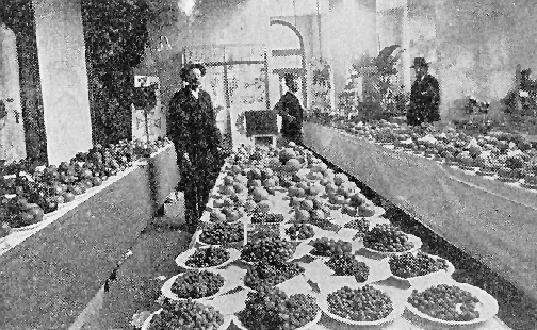
Photo: Colorado Historical Society
More About This Topic
The State Fair helped to improve agriculture in Colorado. Judges gave awards and ribbons for the best produce or animals on display. Farmers who attended the fair could compare their field crops or livestock with the best raised in other parts of the state. The Fair helped them become better farmers or stock growers.
Columbus Day In Craig (1892)
This was the Columbus Day parade in Craig, Colorado. The photo was taken in October 1892. That was the 400th anniversary of Columbus's arrival in America.
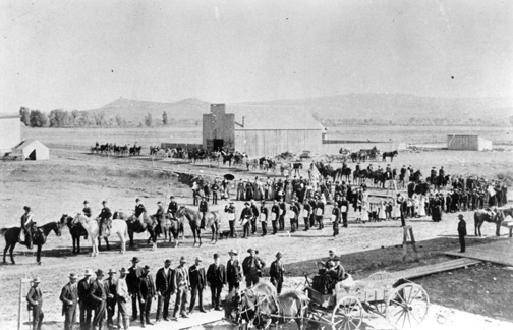
Photo: Denver Public Library, Western History Collection
More About This Topic
The towns in Colorado celebrated national holidays as well as harvest festivals. The Fourth of July, Thanksgiving, and Columbus Day were popular holidays.
Their Own Words
"Christmas, the 4th of July, New Years, and Thanksgiving were always the signal for a community party; we held them at the old hall, a block east of the present City Hall. There was always a big dinner, turkey, roast beef, wild meat; the long tables groaned under the load; and we danced until daylight. My husband was always a rather strict churchman; he did not approve of dancing or music. I loved both. I often played for the dances, and then I was young, I just couldn't help but dance. They were mostly square dances, and lots of fun. He was always cross about it, but I let him pout it out."
Source: Mary Prowers Hudnall, "Early History of Bent County," Colorado Magazine, 22 (1945): 246.

